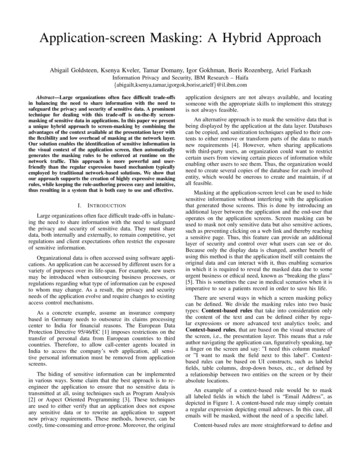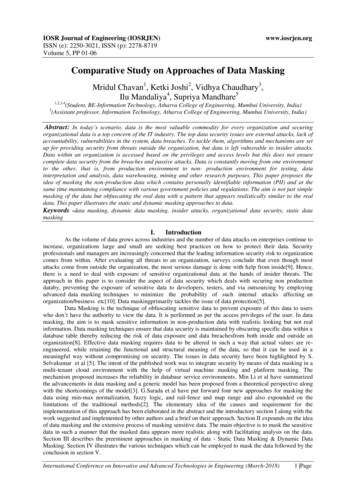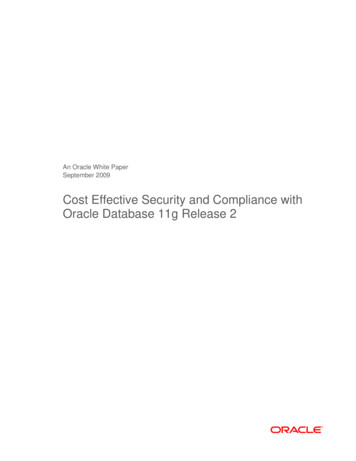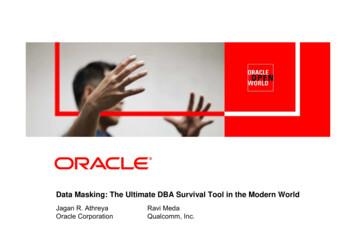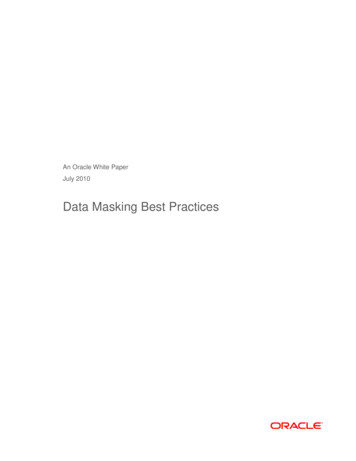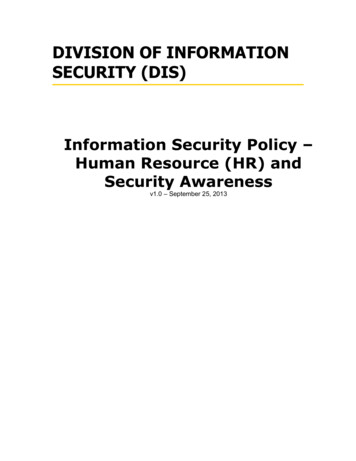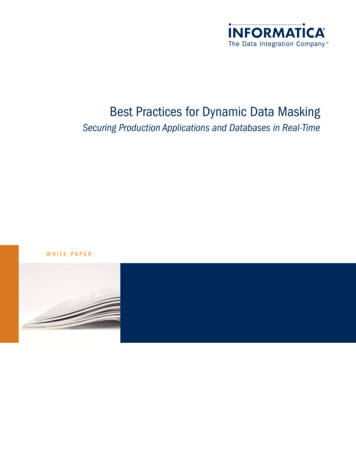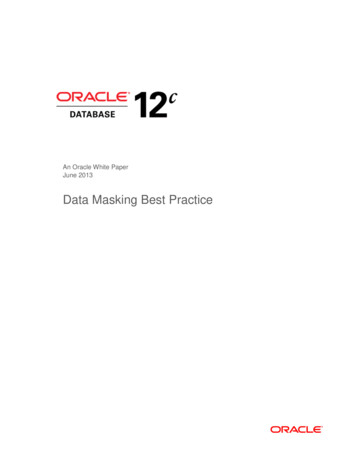
Transcription
An Oracle White PaperJune 2013Data Masking Best Practice
Data Masking Best PracticeExecutive Overview . 2Introduction – Why mask data? . 2The Challenges of masking non-production environments. 4Implementing Data Masking . 5Find: Comprehensive Enterprise-wide Discovery of Sensitive Data . 6Assess: Extensive out-of-the-box optimal masking algorithms . 10Sophisticated Masking Techniques . 11Deterministic Masking . 12Packaged Application Data Masking definition Templates . 13Secure: High Performance Mask Execution. 14Mask in cloned non-production environment. 14At-Source Masking . 16Masking performance tests . 16Test: Integrated Testing with Application Quality Management solutionsData Masking and Subsetting Integration . 19Support for heterogeneous databases . 20Customer Case Studies . 22Conclusion . 2317
Data Masking Best PracticeExecutive OverviewMany organizations inadvertently breach information when they routinely copy sensitive orregulated production data into non-production environments. As a result data in non-productionenvironment has increasingly become the target of cyber criminals and can be lost or stolen.Just like data breaches in production environments, data breaches in non-productionenvironments can cause millions of dollars to remediate and cause irreparable harm toreputation and brand.With Oracle Data Masking, sensitive and valuable information can be replaced with realisticvalues. This allows data to be safely used in non-production and incompliance with regulatoryrequirements such as Sarbanes-Oxley, PCI DSS, HIPAA and as well as numerous other lawsand regulations.This paper describes the best practices for deploying Oracle Data Masking to protect sensitiveinformation in Oracle databases and other heterogeneous databases such as IBM DB2,Microsoft SQLServer.Introduction – Why mask data?Enterprises share data from their production applications with other users for a variety ofbusiness needs. Most organizations if not all copy production data into test and developmentenvironments to allow system administrators to test upgrades, patches and fixes. Businesses to stay competitive require new and improved functionality in existingproduction applications. As a result application developers require an environmentmimicking close to that of production to build and test the new functionality ensuringthat the existing functionality does not break. Retail companies share customer point-of-sale data with market researchers toanalyze customer buying patterns2
Data Masking Best Practice Pharmaceutical or healthcare organizations share patient data with medicalresearchers to assess the efficiency of clinical trials or medical treatments.As a result of the above, organizations copy tens of millions of sensitive customer andconsumer data to non-production environments and very few companies do anything to protectthis data, even when sharing with outsourcers and third parties.Numerous industry studies on data privacy have concluded that companies do not prevent thissensitive data from coming in the hands of wrong-doers. Almost 1 out of 4 companiesresponded that this live data had been lost or stolen and 50% said that they had no way ofknowing if the data in non-production environment had been compromised.To protect and enforce against risk of compromising critical and confidential information, laws,regulations and business policies have been instigated by government and enterprise. As anexample, The Health Insurance Portability and Accountability Act require the protection andconfidential handling of protected health information. Also, the Payment Card Industry (PCI)Data Security Standard (DSS) which is enforced by Visa and Master Card was development toencourage and enhance cardholder data security and to facilitate the broad adoption ofconsistent data security measures globally. PCI DSS provides a baseline of technical andoperational requirements designed to protect cardholder data.With the explosion of E-commerce , business do not typically encrypt data beyond what isrequired because doing so degrades the performance of the production environment and alsohamper non-production activities. Two thousand and eleven proved to be an unprecedentedyear for headlines about major database break-ins at Sony, Google, Bank of America, RSA,Lockheed, Epsilon, Nasdaq Directors Desk and the US Chamber of Commerce among manyothers. Hence, just like data breaches in production environments that has been reported in2011, data breaches in non-production environment can cause irreparable harm to thereputation and brand. Enterprises that has spent over a decade in building their reputation, canpainfully take so many steps backwards due to a single incident. Security experts andtechnologists point to several developments that suggest the pattern is likely to continue in2013 as it did with Zappos in 2012.Protecting vital company information in non-production environment has become one of theforemost critical tasks over the recent years. With Oracle Data Masking pack sensitive andvaluable information can be replaced with realistic values. This allows production data to be3
Data Masking Best Practicesafely used for development, testing, outsource partners and off-shore partners or other nonproduction purposes.The Challenges of masking non-production environmentsOrganizations have taken these threats seriously and have set out to address these issues asquickly as possible knowing the ramifications. However, the idea of simply removing sensitiveinformation from non-production environment seems to be simple, it can pose seriouschallenges in various aspects.Some of the immediate challenges are identifying sensitive information. What defines sensitiveinformation? Where does it reside? How is it referenced? Applications have become verycomplex and integrated. Knowing where the sensitive information resides and whatapplications are referencing this information becomes a daunting task. Culminated with theever evolving application, the challenge also becomes maintaining meta-data knowledge of theapplication architecture though-out its lifecycle.Once sensitive information has been identified, the process of masking while maintainingapplication integrity becomes paramount. Simply changing the value will inadvertently breakthe application that is being used to test, develop or upgrade. As an example masking a part ofa customer’s address, such as zip without consideration of city and state, may render theapplication unusable. Hence developing or testing becomes if not impossible, unreliable.Auditing is another challenge that is considered seriously. Knowing who changed what andwhen becomes an important business control requirement to prove compliance withregulations and laws. To implement these types of controls, the challenge becomesseparations of duties, role based permissions and the ability to report on these activities.Databases are becoming very large and the frequency of requests for a secure non-productionenvironment to be available has drastically increased over the years. The reason for thisincrease is for business to develop newer and better applications which services theircustomers at a faster pace to stay competitive. A masking process needs to have acceptableperformance and reliability.And finally having a flexible solution that can evolve with the application and extend to otherapplications within an enterprise becomes an important challenge to address.4
Data Masking Best PracticeAs a result of these challenges, unfortunately organizations have tried to address these issueswith custom hand-crafted solutions or repurposed existing data manipulation tools within theenterprise to solve this problem of sharing sensitive information with non-production users.Take for example, the most common solution: database scripts. At first glance, an advantageof the database scripts approach would appear that they specifically address the uniqueprivacy needs of a particular database that they were designed for. They may have even beentuned by the DBA to run at their fastestLet’s look at the issues with this approach.1.Reusability: Because of the tight association between a script and the associateddatabase, these scripts would have to be re-written from scratch if applied to anotherdatabase. There are no common capabilities in a script that can be easily leveraged acrossother databases.2.Transparency: Since scripts tend to be monolithic programs, auditors have notransparency into the masking procedures used in the scripts. The auditors would find itextremely difficult to offer any recommendation on whether the masking process built into ascript is secure and offers the enterprise the appropriate degree of protection.3.Maintainability: When these enterprise applications are upgraded, new tables andcolumns containing sensitive data may be added as a part of the upgrade process. With ascript-based approach, the entire script has to be revisited and updated to accommodate newtables and columns added as a part of an application patch or an upgrade.Implementing Data MaskingWith these enterprise challenges in mind, Oracle has development a comprehensive 4-stepapproach to implementing data masking via Oracle Data Masking Pack called: Find, Assess,Secure and Test (F.A.S.T). These steps are: Find: This phase involves identifying and cataloging sensitive or regulated data acrossthe entire enterprise. Typically carried out by business or security analysts, the goal of thisexercise is to come up with the comprehensive list of sensitive data elements specific to the5
Data Masking Best Practiceorganization and discover the associated tables, columns and relationships across enterprisedatabases that contain the sensitive data. Assess: In this phase, developers or DBAs in conjunction with business or securityanalysts identify the masking algorithms that represent the optimal techniques to replace theoriginal sensitive data. Developers can leverage the existing masking library or extend it withtheir own masking routines. Secure: This and the next step may be iterative. The security administrator executesthe masking process to secure the sensitive data during masking trials. Once the maskingprocess has completed and has been verified, the DBA then hands over the environment tothe application testers. Test: In the final step, the production users execute application processes to testwhether the resulting masked data can be turned over to the other non-production users. If themasking routines need to be tweaked further, the DBA restores the database to the premasked state, fixes the masking algorithms and re-executes the masking process.We will now dive deep into the individual steps and cover the best practice for enterprises tosecure their non-production environment effectively using Oracle Data Masking.Find: Comprehensive Enterprise-wide Discovery of Sensitive DataTo begin the process of masking data, the data elements that need to be masked in theapplication must be identified. The first step that any organization must take is to determinewhat is sensitive. This is because sensitive data is related to specific government regulationsand industry standards that cover how the data can be used or shared. Thus, the first step isfor the security administrator to publish what constitute sensitive data and get agreement fromthe company’s compliance or risk officers.Once the sensitive elements have been decided upon, the next step involved is locating, orfinding these sensitive elements in the databases. With Oracle Data Masking Pack, the DataDiscovery and Modeling capability in Oracle Enterprise Manager, enterprises can define datapattern search criteria’s allowing security administrators to locate these sensitive elements. For6
Data Masking Best Practiceexample data pattern’s such has 15- or 16-digits for credit card numbers or 9-digit formattedUS social security numbers.Figure 1. Sensitive Column Type definitionOnce all the sensitive elements have been defined, the system administrator will then schedulea discovery job in Enterprise Manager which will introspect the database application ofconcern.Figure 2. Sensitive column discoveryThe search results returned are then ranked based on the probability of a match allowing thesecurity administrator to designate the column as sensitive for inclusion in the maskingprocess or not sensitive for exclusion from future ad hoc pattern searches.7
Data Masking Best PracticeFigure 3. E-Business Suite template pre-defined sensitive columnsDefining and identifying sensitive data to mask is only part of the solution. It is also, importantto ensure data integrity to maintain correct application behavior after masking and to ensureintegrity you must consider referential data relationships.Today’s relational databases store data in tables related by certain key columns called primarykey columns to allow for efficient storage of application data without having to duplicate data.For example, an EMPLOYEE ID generated from a human capital management (HCM)application may be used in sales force automation (SFA) application tables using foreign keycolumns, in a database or across databases. EMPLOYEESEMPLOYEE IDFIRST NAMELAST NAMEDatabase enforcedApplication enforcedFigure 4. The Importance of Referential Integrity8CUSTOMERS CUSTOMER IDSALES REP IDCOMPANY NAMESHIPMENTS SHIPMENT IDSHIPPING CLERK IDCARRIER
Data Masking Best PracticeOracle Data Masking Pack automatically detects data dependencies such as foreign keyconstraints ensuring referential integrity. What this means, is that as part of the discovery ofsensitive columns, Data Discovery and Modeling will also introspect database enforcedrelationships and stores them with the sensitive columns. This logical containment of entities,their relationships and the sensitive columns for an application or many applications is referredto as the Application Data Model (ADM) and is stored in the Enterprise Manager repository.Application Data Model provides a robust mechanism by which security administrators canmaintain this application meta-data knowledge and repeatedly use it as the building blocks formasking sensitive data in an enterprise, as we will mention later in this document. ApplicationData Model also allows the system administrator to maintain the sensitive columns very easilythroughout the lifecycle of the application. Additionally, any modifications to the data model issimply performed my editing the data model within Enterprise Manager.In addition to the above easy-to-use mechanism for isolating sensitive data elements andunderstanding the relationships, Oracle Data Masking Pack delivers meta-data knowledge ofpackaged applications in the form of templates that allow enterprises to quickly get started inmasking sensitive data. Let us take Oracle E-Business Suite Data Masking Template as anexample. This template contains out-of-the-box, meta-data knowledge of the E-Business Suitearchitecture and sensitive columns. It covers all product families shipped with Oracle EBusiness Suite and contains PII and other sensitive personal meta-data knowledge associatedwith users. Additionally, EBusiness Suite, like any other packaged application, requires certainsystem users not be masked. This allows for the continued use of the application after maskingso that developers, QA or non-production users can use the environment. This capability isprovided for in the template and allows customers to add exempt users from masking byinserting into the table FND USER MASKING EXEMPTIONS table. Follow the steps outlinedin MOS Note: 1481916.1Some of the attributes that are masked in the Oracle E-Business Suite Data Masking templateare (For a complete list please refer to MOS Note 1481916.1):TABLE 1. PARTIAL LIST OF ATTRIBUTES MASKED IN ORACLE E-BUSINESS SUITE DATA MASKING TEMPLATE9SENSITIVE ATTRIBUTEPII ATTRIBUTECompensationPerson Name
Data Masking Best PracticeEmployment DetailsEmployee NumberNationality / CitizenshipAccount NameHealth InformationGPS LocationSession InformationNational IdentifierAudit InformationDeriver License NumberNote that in the E-Business Suite Template, financial data such as results, forecasts, designspecifications, unstructured data such as Descriptive Flex fields, notes, attachments andinternal primary keys such as user id or person id are not maskedThe templates that are currently available at time of writing are Oracle E-Business Suite andOracle Fusions Applications. PeopleSoft data masking templates are scheduled to be in thenext PSFT release.Assess: Extensive out-of-the-box optimal masking algorithmsData masking is in general a trade-off between security and reproducibility. A test databasethat is identical to the production database is 100% in terms of reproducibility and 0% in termsof security as it exposes the original data to non-production users. Masking technique wheredata in sensitive columns is replaced with a single fixed value is 100% in terms of security and0% in terms of reproducibility. When considering various masking techniques, it is important toconsider this trade-off in mind when selecting the masking algorithms.After the Application Data Model has been built and the security administrator has identified allthe sensitive columns that are required to be masked per rules and regulations, developersand or DBAs in conjunction with business security analysts identify the masking algorithms thatrepresent the optimal techniques to replace the original sensitive data.Oracle Data Masking provides a centralized library of out-of-the-box mask formats for commontypes of sensitive data, such as credit card numbers, phone numbers, national identifiers(social security number for US, national insurance number for UK). By leveraging the FormatLibrary in Oracle Data Masking, enterprise can apply data privacy rules to sensitive dataacross enterprise-wide databases from a single source and thus, ensure consistentcompliance with regulations. Enterprise can also extend this library with their own maskformats to meet their specific data privacy and application requirements.10
Data Masking Best PracticeFigure 5. Central Format LibraryOracle Data Masking also provides mask primitives, which serve as building blocks to allowthe creation of nearly unlimited custom mask formats ranging from numeric, alphabetic ordate/time based. Recognizing that the real-world masking needs require a high degree offlexibility, Oracle Data Masking allows security administrators to create user-defined-masks.These user-defined masks, written in PL/SQL, let administrators create unique mask formatsfor sensitive data, e.g. generating a unique email address from fictitious first and last names toallow business applications to send test notifications to fictitious email addresses.Commonly, enterprises require advanced masking rules to be used to maintain privacy ofsensitive data and allow the application to continue functioning in a realistic manner. OracleData Masking provides a variety of sophisticated masking techniques to meet these applicationrequirements while ensuring data privacy. Let us have a look at someSophisticated Masking TechniquesThese techniques ensure that applications continue to operate without errors after masking.For example, Condition-based masking: this technique makes it possible to apply different maskformats to the same data set depending on the rows that match the conditions. As anexample, it is common that a global business will have employees in differentcountries, such as the US and UK. In the US, the national identifier of a person is thesocial security number which is 9 digits long where as in UK it is the national insurancenumber which is 9 alphanumeric long. Both of these may reside in the same column,and after masking the applications may need to keep the same characteristics of thedata yet masked to ensure correct functionality. To determine what the format the data11
Data Masking Best Practiceshould be masked in, condition based masking of Oracle Data Masking Pack allowsthe functionality to check a country code and use the appropriate algorithm on thenational identifier column Compound masking: this technique ensures that a set of related columns is maskedas a group to ensure that the masked data across the related columns retain the samerelationship, e.g. city, state, zip values need to be consistent after masking. Deterministic masking: this technique ensures repeatable masked values after amask run. Enterprise may use this technique to ensure that certain values, e.g. acustomer number gets masked to the same value across all databases. We willelaborate on this technique as it is a very common use case. Key-based reversible masking: when businesses need to send their data to a 3rdparty for analysis, reporting or any other business process, this technique transformsthe original data into a masked representation of itself using a secure key-basedreversible masking function. Once the data is recovered from the 3rd party, thebusiness can recover the original data by reversing the masking using the same keyDeterministic MaskingDeterministic masking is an important masking technique that enterprises must consider whenmasking key data that is referenced across multiple applications. Take, for example, threeapplications: a human capital management application, a customer relationship managementapplication and a sales data warehouse. There are some key fields such as EMPLOYEE IDreferenced in all three applications and needs to be masked in the corresponding test systems:a employee identifier for each employee in the human resources management application,customer service representative identifiers, which may also be EMPLOYEE IDs, in thecustomer relationship management application and sales representative IDs, which may beEMPLOYEE IDs in the sales data warehouse.To ensure that data relationships are preserved across systems even as privacy-relatedelements are removed, deterministic masking techniques ensure that data gets maskedconsistently across the various systems. It is vital that deterministic masking techniques usedproduce the replacement masked value consistently and yet in a manner that the original datacannot be derived from the masked value.12
Data Masking Best PracticeOne way to think of these deterministic masking techniques is as a function that is applied onthe original value to generate a unique value consistently that has the same format, type andcharacteristics as the original value, e.g. a deterministic function f(x) where f(x1) will alwaysproduce y1 for a given value x1. In order for the deterministic masking to be appliedsuccessfully, it is important that the function f(x) not be reversible, i.e. the inverse function f1(y1) should not produce x1 to ensure the security of the original sensitive data.Deterministic masking techniques can be used with mathematical entries, e.g. social securitynumbers or credit card numbers, as well as with text entries, e.g., to generate names. Forexample, organizations may require that names always get masked to the same set of maskednames to ensure consistency of data across runs. Testers may find it disruptive if theunderlying data used for testing is changed by production refreshes and they could no longerlocate certain types of employees or customer records that were examples for specific testcases. Thus, enterprises can use the deterministic masking functions provided by Oracle DataMasking to consistently generate the same replacement mask value for any type of sensitivedata element.Deterministic masking becomes extremely critical when testing data feeds coming fromexternal systems, such as employee expense data provided by credit card companies. Inproduction environments, the feed containing real credit card numbers are processed by theaccounts payable application containing employee’s matching credit card information and areused to reconcile employee expenses. In test systems, the employee credit card numbershave been obfuscated and can no longer be matched against the data in the flat filescontaining the employee’s real credit card number. To address this requirement, enterprisespre-load the flat file containing data using tools such as SQL*Loader, into standard tables, thenmask the sensitive columns using deterministic masking provided by Oracle Data Masking andthen extract the masked data back into flat file. Now, the application will be able to process theflat files correctly just as they would have been in Production systems.Packaged Application Data Masking definition TemplatesAs seen above, the complexity of the algorithm will depend on the logic of the application andthe rules and regulations that enterprise abide by to secure sensitive columns. This becomesfurther complicated in packaged applications such as E-Business Suite, PeopleSoft andFusion Applications. To ease this complexity, Oracle has released, E-Business Suite, FusionApplications and will be releasing (PeopleSoft) Data Masking definition templates that work inconjunction with Application Data Model templates as described above. These data masking13
Data Masking Best Practicedefinition templates contain pre-defined industry best-practice masking algorithms to ensurethe optimal techniques is used to securely mask the data while maintaining the applicationintegrity to allow for correct application behavior.With respect to E-Business Suite Data Masking template, enterprise should reference theMyOracle Support Note: 1481916.1, which provides an overview of data masking in Oracle EBusiness Suite, along with instructions on how to set up the Oracle E-Business Suite Release12.1.3 Template for Data Masking Pack with Oracle Enterprise Manager 12c Data MaskingTool.With respect to Oracle Fusion Applications and Data Masking, you should refer to OracleFusion Applications Administrator’s Guide Section 6.9 Data Masking in Oracle FusionApplications. The section contains an introduction to Data Masking in Oracle FusionApplications and a step-by-step instruction of installing the templates and executing.When masking an Oracle Fusion Application that has been masked, only the Fusion databaseis masked. Hence it is important to note that the Enterprise Scheduler Service (ESS) job tosynchronize the LDAP identity store and the Oracle Fusion Application database not be run.Doing so will rest the identity attributes in the database to their unmasked values.You should also setup test users to perform the testing. One should not log into the testdatabase as a real user or update a user’s attribute in either the LDAP identity store or theOracle Identity Manager database. Doing so will reset that user’s attributes to their unmaskedvalues.Secure: High Performance Mask ExecutionNow that the mask definition is compete, the security administrator can execute the maskingprocess to replace all sensitive data. However before doing so, the administrators of theproduction environment will have to choose whether to clone the production environment into arestricted, fenced off location outside of production and mask or to perform At-Source masking.We will discuss both routes below.Mask in cloned non-production environmentOracle Enterprise Manager offers several options to clone the production database:14
Data Masking Best Practice Recover from backup: Using Oracle Managed Backups functionality, Oracle Enterprisemanager can create a test database from an existing backup. Clone Live Database: Oracle Enterprise Manager can clone a live production databaseinto any non-production environments within a few clicks. The clone databasecapability also provides the option to create a clone image, which can then be used forother cloning operations.With the restricted, cloned non-production database now ready for masking, the Oracle DataMasking builds a work-list of the tables and columns chosen for masking. Other tables that arenot required to be masked are not touched. Further, the tables selected for masking areprocessed in the optimal order to ensure that only one pass is made at any time even if thereare multiple columns from that table selected for masking. Typically, the tables with the primarykeys get masked first, followed by the dependent tables containing foreign keys.Once the mask work list is ready, the Oracle Data Masking generates mapping tables for allthe sensitive fields and their corresponding masked values. These are temporary tables thatare created as a part of the masking process, which will be dropped once all data has beenmasked successfully.Using a highly efficient data bulk mechanism, Oracle Data Masking rapidly recreates themasked replacement table based on original tables and the mapping tables and restores allthe related database elements, such as indexes, constraints, grants and triggers identical tothe original table. Compare this with the typical data masking process, which usually involvesperforming table row updates. Because rows in a table are usually scattered all over the disk,the update process is extremely inefficient because the storage systems attempts to locate
Implementing Data Masking With these enterprise challenges in mind, Oracle has development a comprehensive 4-step approach to implementing data masking via Oracle Data Masking Pack called: Find, Assess, Secure and Test (F.A.S.T). These steps are: Find: This phase involves identifying and cataloging sensitive or regulated data across
